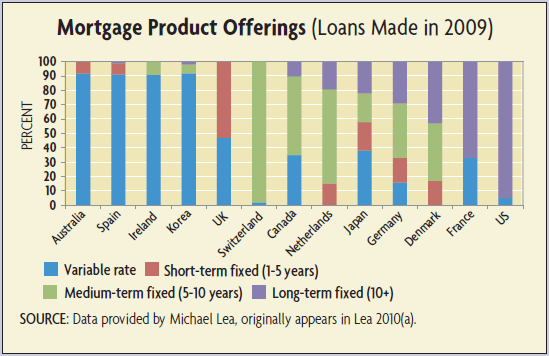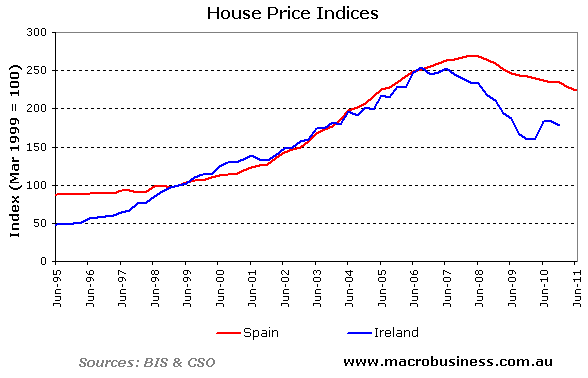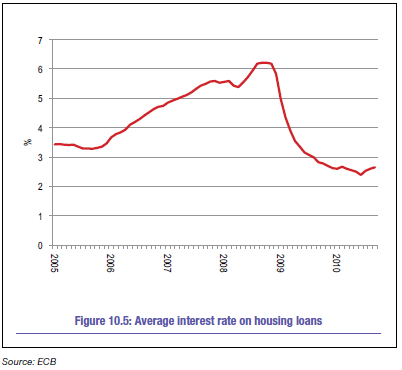Last month, the Federal Reserve Bank of Richmond published a report, Foreign Housing Finance, which highlights a number of problems with the US mortgage financing system and proposes a number of reforms based largely on the financing systems employed in other developed nations.
While the entire report is interesting, the below chart, in particular, grabbed my attention:

According to this chart, around 90% of mortgages in Australia, Spain, Ireland and Korea are variable rate. By contrast, the reciprocal is true in the US, where over 90% of mortgages are fixed-rate.
Now we have all heard the claim that Australia’s housing market would be protected from a US-style collapse because, amongst other reasons, the overwhelming majority of mortgages are floating rate. And the implication of having a floating rate system is that any reduction in official interest rates by the Reserve Bank of Australia (RBA) would flow more or less directly into mortgage rates and support house prices because:
- forced sales would be discouraged due to the lower interest burden on pre-existing mortgages; and
- potential home buyers would be encouraged into the housing market by the lower mortgage rates on offer.
The hypothesis explained above runs in stark contrast to the experience of the US where, because of the widespread use of fixed-rate mortgages, the Federal Reserve was largely impotent in its ability to reduce the interest rate on fixed-rate mortgages via monetary policy.
Putting to one side the debate over whether Australia is facing a US-style housing crash (highly unlikely in my view), Ireland and Spain provide a useful test of the thesis that Australia’s variable rate mortgage structure, combined with a reduction in official interest rates by the RBA, would prevent home values fall falling significantly.
Both Ireland and Spain have experienced sharp house price declines despite having a similar share of variable rate mortgages:

There is, however, one important difference between the Spanish and Irish mortgage financing systems to Australia’s: because Spain and Ireland are members of the European Union (EU), their interest rates are set by the European Central Bank (ECB). So, in contrast to the RBA, which has the ability to directly influence mortgage rates when it sees fit, control over Spanish and Irish interest rates is vested in the ECB, which sets rates based on the EU as a whole, not individual member countries.
Because of this important difference, interest rates in Ireland and Spain were arguably set too low during the boom years and then were not reduced quickly enough during the down turn. The below chart, which has been sourced from the latest RICS European Housing Review, shows average mortgage rates in Spain since 2005 (rates would have been similar in Ireland, given they are set via the same ECB official interest rate).

As you can see, mortgage rates plummeted from around 6% to 3% in the six months to mid-2009. Yet Spanish house prices, which had peaked in mid-2008, continued falling.
Irish house prices, on the other hand, had peaked a year earlier in mid-2007, and the sharp reduction in mortgage interest rates arguably came far too late to arrest the slide.
Overall, it is hard to argue against the claim that Australia’s variable mortgage rate structure could help significantly in mitigating any housing adjustment caused by, say, a China hard landing or some other major external shock. While slashing official interest rates probably wouldn’t prevent house prices from falling altogether, they could at least turn a potential crash into a more modest adjustment – perhaps something in between the ‘slow melt’ currently being experienced in New Zealand and a UK-style correction.
As was illustrated by the Irish and Spanish experiences, the key to whether Australia’s variable rate structure is ultimately successful in forestalling any adverse shock would depend largely on whether the RBA acts quickly and decisively in dropping rates.
What do you think? Would Australia’s variable mortgage rate structure prevent house prices from crashing in the event that China experiences a hard landing (or we experience some other major shock)?

